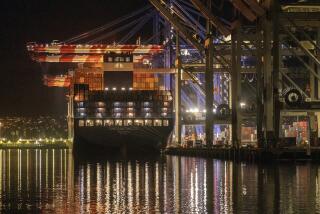L.A., Long Beach ports see cargo drop in February
The ports of Los Angeles and Long Beach saw more of a decline in cargo traffic in February than other ports around the nation, perhaps proving there is one month out of the year in which there’s little advantage in having China as a primary trading partner.
That’s because of the annual Chinese New Year celebration. Chinese factories traditionally close for the celebration for a week or more. This year, the factory slowdown hit trade traffic in February. The ports of Los Angeles and Long Beach, the busiest U.S. seaport complex, move 40% of the nation’s Asian imports, and most of that comes from China.
Other ports, whose trade figures include a higher percentage of traffic from Europe, Central America, South America and some South Asian nations, saw less of a decline in imports in February.
“We have one bad month every year,” said Art Wong, a spokesman for the Port of Long Beach, “and every year, it’s been related to the Chinese New Year. “This month, the slowdown occurred entirely in February and it turned four weeks of cargo into three weeks.”
The ports of Los Angeles and Long Beach rank first and second in the nation, respectively, in cargo container traffic, making them and the associated logistics of moving freight to and from the rest of the nation important employers in Southern California.
In February, imports through the port of Los Angeles fell to 254,360 containers, down 7.8% from a year earlier. But it was another strong month for exports through the trade hub as the numbers rose 9.56% to 164,725 containers.
Phillip Sanfield, a spokesman for the Port of Los Angeles, said it was the 21st consecutive month of export growth at the harbor. Overall in February, Los Angeles handled 525,653 containers, including empty ones, in February. That was down 5.27% from 554,913 a year earlier.
Long Beach imports dropped 18.05% to 191,475 containers and exports fell 1.58% to 120,006. Overall, the port moved 388,589 containers, down 15.2% from a year earlier.
The two seaports moved a little less than 2.1 million containers during the first two months of the year, compared with more than 2.1 million in the same two months of 2011.
Other seaports saw less of a decline in February, according to the Minneapolis-based Zepol Corp., which tracks international trade. Zepol said U.S. import shipments dropped 3.4% compared with February 2011.
Import trade is expected to grow at all of the nation’s major seaports in March and well into the summer months, according to the National Retail Federation and Hackett Associates.
The Inland Empire counties of San Bernardino and Riverside, which bristle with warehouses tied to international trade, have climbed to the top of the job growth ladder in Southern California for the first time since the recession, according to John Husing of Redlands-based research firm Economics and Politics Inc.
The Inland Empire added 19,200 jobs in January, more than Orange County (up 11,300), San Diego County (up 10,100) and Los Angeles County (up 9,500), he said.
More to Read
Inside the business of entertainment
The Wide Shot brings you news, analysis and insights on everything from streaming wars to production — and what it all means for the future.
You may occasionally receive promotional content from the Los Angeles Times.











